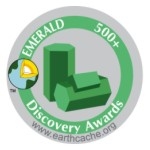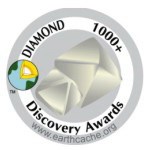Stone Mountain, N.C. Earthcache EarthCache
Stone Mountain, N.C. Earthcache
-
Difficulty:
-

-
Terrain:
-

Size:  (not chosen)
(not chosen)
Please note Use of geocaching.com services is subject to the terms and conditions
in our disclaimer.

STONE MOUNTAIN

Stone Mountain in Stone Mountain State Park in North Carolina is a Monadnock.
WHAT IS A MONADNOCK?
A monadnock or inselberg is an isolated hill, knob, ridge, or small mountain that rises abruptly from a gently sloping or virtually level surrounding plain. In southern and southern-central Africa, a similar formation of granite is known as a kopje from the Afrikaans word: koppie. In fact the word koppie is itself frequently employed in written South African English.
Monadnock is an originally Native American term for an isolated hill or a lone mountain that has risen above the surrounding area, typically by surviving erosion. The name was taken from Mount Monadnock in southwestern New Hampshire (USA), in Jaffrey. The name is thought to derive from the Abenaki language, from either menonadenak ("smooth mountain") or menadena ("isolated mountain").
The word inselberg is German for "island mountain"; the name was originally coined to describe the abundant such features found in southern Africa. The term monadnock is more usually used in the US.
Inselbergs are typically, though not only, formed in tropical areas. Volcanic or other processes may give rise to a body of rock resistant to erosion, inside a body of softer rock such as sandstone which is more susceptible to erosion. When the less resistant rock is eroded away to form a plain, the more resistant rock is left behind as an isolated mountain. If the inselberg is dome-shaped and formed from granite-gneiss, it can also be called a bornhardt.
MORE INFORMATION
Stone Mountain is the centerpiece of Stone Mountain State Park. It is a dome of exposed granite (specifically a quartz diorite to granodiorite) of Devonian age, which has intruded into the gneiss of the Precambrian Alligator Back Formation.[1] It rises sharply over 600 feet above the surrounding terrain. The mountain, which has an elevation of 2,305 feet (706 m) above sea level, is known for its barren sides and distinctive brown-gray color, and can be seen for miles. The mountain offers some of the best rock climbing in North Carolina, and the park's creeks and streams feature excellent brook trout fishing.
Because the mountain is the best example of a monadnock in massive granite in North Carolina it was designated a National Natural Landmark in May 1974
ADMISSION - There is no admission to enter the park.
PARK HOURS - are as follows:
November to February 8 AM to 6 PM March, April, September & October 8 AM to 8 PM May to August 8 AM to 9 PM Closed on Christmas Day
FLY FISHING in more than 20 miles of designated trout waters.
HIKING on more than 18 miles of hiking trails.
SIZE OF PARK: Greater than 14,100 acres
LOCATION: Located in both Wilkes and Alleghany counties.
DRIVING DIRECTIONS: Stone Mountain State Park is located seven miles southwest of Roaring Gap.
From I-77 North, take Exit #83/Hwy US 21 North/Sparta/Roaring Gap (you will exit from the left lane). Go north about 13 miles to Traphill Road/ State Road 1002, (you will see a brown state park sign) and turn left. Go about 4 miles to John P Frank Parkway (you will see a brown state park sign) and turn right. Follow the parkway to the park.
From the west, take NC 16 to NC 18 in North Wilkesboro and then turn right onto Hwy 268 East. Go about 3 miles and turn left at Airport Road. Go about 4 miles and turn left this becomes Traphill Rd (SR 1002). Follow Traphill Rd to John P. Frank Parkway about 11 miles and turn left, follow the parkway to the park.
MOUNTAIN CULTURE EXHIBIT: Located at the park office, this exhibit tells the story of how the independent mountain settlers provided shelter, food, and clothing for their families. Included is an old time still, loom, and other historical artifacts and includes animal pelts and a full body black bear mount.
HUTCHINSON HOMESTEAD: Walk through one of the park’s historic sites, the Hutchinson Homestead. The homestead is complete with a log cabin with original furnishings, barn with implements, blacksmith shop, corncrib, and meat house. The original farm was built in the mid 19th century and restored in 1998.
The homestead is open to visitors weekends during peak season. When the homestead is closed during the week and during winter, visitors can walk the homestead grounds.
REQUIREMENTS TO LOG THIS EARTHCACHE:
Email the answers to questions 1 thru 4 to me at my above profile email address.
1. Go to the above listed coordinates, which is the visitors center. You can see Stone Mountain from:
A. the parking lot.
B. the information sign.
C. the second floor deck.
2. What causes the stain marks that run down the mountain?
3. Name two other Monadnocks in the World and give their location.
4. Drive two and one half miles from the visitors center to the lower parking lot at N 36 23.900 W 081 03.033 and either drive or hike to the Hutchinson Homestead. It is about a one half mile hike (mostly uphill). How many windows are in the main house?
5. Walk to the barn at N 36 23.496 W 081 02.909 and have your picture taken with the stone mountain in the background and you holding your GPSr. Upload this picture with your find log, .
I request that you email your answers to me on the same day that you log your found it log. (This does not have to be the day you visit, just the day you log the find on the computer.) I also request that you do not log a “found it” log unless you have actually visited the site of the earthcache and sent the answers to me. The only person who really benefits from your visit is YOU.
Each cacher is required to send the required information and not rely on another cacher to provide it. Failure to follow this procedure will result in a deleted log. It is not my job to keep track of your group.
XXXXXXXXXXXXXXXXXXXXXXXXXXXXXXXXXXXXXXXXXXXXXXXXXXXXXXXXXXXXXXXXXXXXXXXXXXXXXXXX
We became Platinum Earthcache Masters on September 17, 2007.
We were the first to request and receive on July 2, 2011 the Emerald Discovery Award for finding 500 or more Earthcaches.
We received the Diamond Discovery Award on June 17, 2012 for finding 1,000 or more Earthcaches.



XXXXXXXXXXXXXXXXXXXXXXXXXXXXXXXXXXXXXXXXXXXXXXXXXXXXXXXXXXXXXXXXXXXXXXXXXXXXXXX

Additional Hints
(No hints available.)